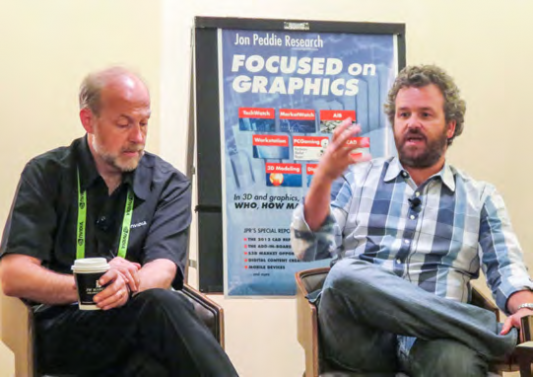Panelists at the Jon Peddie Research Siggraph press luncheon found much to cheer about in the rise of powerful multicore processors, even if the gains are not being uniformly embraced.
When James Cameron talks about the technology behind his blockbuster film “Avatar,” he often says he had to wait to make the film until the technology was ready. Today the technology Cameron waited for—and in some cases, helped to invent—is commercially available, all of it powered by massive multicore CPU and GPU processors. In a panel discussion at Siggraph 2012 in Los Angeles sponsored by Jon Peddie Research, five CG technologists and creators discussed the pros and cons of life in the multicore era.

In the first years of digital media, creative processes had to take a backseat to the requirements and rhythms of working in silicon instead of celluloid. But today’s processor power not only makes possible special effects never before possible, it is also accelerating production time. Rob Powers, president of a new division of NewTek devoted to 3D technology, says the lag time between a director’s change request and a review of the result is disappearing. “We are getting back to the way film was made 20 years ago,” he says.
Jacob Rosenberg says today’s GPU technology is accelerating tasks that have been a bottleneck to film crews in the digital era. As CTO of Bandito Bros.—best known for their recent hit film Act of Valor—Rosenberg says one of the big benefits is that it levels the playing field for small production firms like his. Bandito Bros. now can color-correct in the studio instead of sending it out to a specialty house. Rendering that took hours or days in the past have been cut down significantly, allowing “as final” viewing of scenes during production.
Faster production is not the only by-product of multicore technology. James McCombe of Caustic Graphics/ Imagination Technologies says the ability to move production work from “towers to laptops” is having an immense impact on film and game production. Caustic is a ray-tracing specialist, and McCombe notes the very best effects in ray tracing are the product of “power and size.” For those willing to move ray tracing to the cloud, the power is now available from an iPad. But in the secretive world of high-stakes film and game production, many users are not ready or willing to send projects to the cloud. For these users, the challenge remains of scaling down high-end ray-tracing technology to the laptop; McCombe says it is a work in progress and notes that next-generation smartphones will come with 100+ cores—albeit simple ones.
The JPR panelists were split on the desirability of cloud computing. Phillip Miller of Nvidia notes that powerful graphics processing is now available on “any device, anywhere” and says “latency is the last enemy to be conquered.” David Forrester, managing director of rendering software vendor Lightworks, sees the same issues as McCombe. “Our customers are not requesting cloud services,” says Forrester. “Until intellectual property issues are addressed they won’t use it.” Many Lightworks customers are extremely protective of their data and only use internal render farms. “We are skeptical,” he says.
Engineering has different issues
The compute-intensive tasks required to create CG for film and gaming are highly iterative in nature and easily parallelized for processing on multiple CPU and GPU cores. But CAD graphics rely on intensive, proprietary algorithms and complex interrelationships that operate in serial fashion and are not easy to distribute in parallel to a cluster of processing cores. Current hardware designs are not helping the problem, notes Nvidia’s Miller: “The pipe between CPU and GPU has not increased in size; there are too many ‘touches’ between the two.” Miller says Nvidia recently consulted with one CAD vendor and helped it decrease large assembly display regeneration by 15% “just by cleaning up the graphics pipeline.”
Caustic’s McCombe also sees the serial nature of CAD algorithms as a big part of the problem. “New algorithms are needed; there are [too many] serial dependencies. The research has not been done to evolve this. This isn’t about adding even more cores, but optimizing code to use what is available now.”
Powers of NewTek has a different perspective. Optimization is coming to CAD software, he says, and users will see “crazy performance increases” coming soon to many CAD products as vendors release new versions optimized for multicore technology.
Clearly split
The comments on cloud computing and the strong algorithmic distinctions between rendering images and calculating geometry show there is still much work to be done to make professional computer graphics work possible anytime, anywhere, on any platform. We are in an unusual place in the computer revolution: we trust banks with holding our money in a digital vault we can access from a browser, but many will not let a cloud services vendor touch their cartoon images or product designs.





